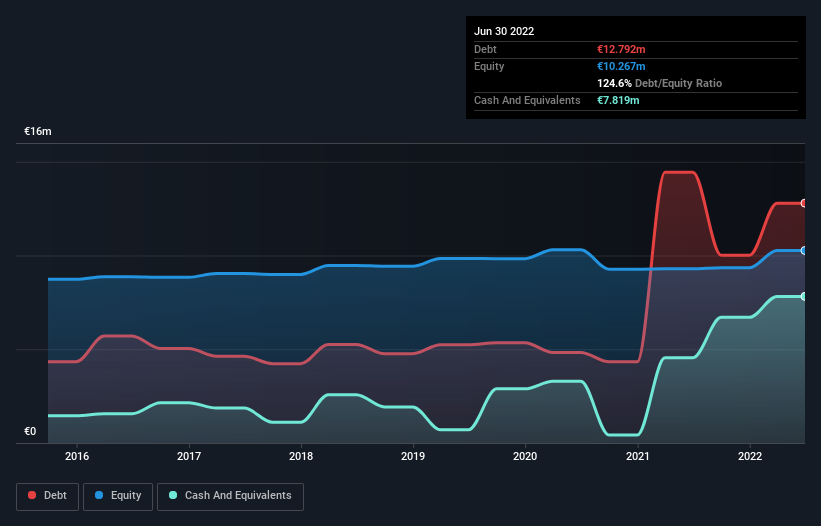
Warren Buffett famously said, 'Volatility is far from synonymous with risk.' It's only natural to consider a company's balance sheet when you examine how risky it is, since debt is often involved when a business collapses. Importantly, Park & Bellheimer AG (FRA:PKB) does carry debt. But should shareholders be worried about its use of debt?
When Is Debt Dangerous?
Debt is a tool to help businesses grow, but if a business is incapable of paying off its lenders, then it exists at their mercy. Part and parcel of capitalism is the process of 'creative destruction' where failed businesses are mercilessly liquidated by their bankers. However, a more frequent (but still costly) occurrence is where a company must issue shares at bargain-basement prices, permanently diluting shareholders, just to shore up its balance sheet. Of course, the upside of debt is that it often represents cheap capital, especially when it replaces dilution in a company with the ability to reinvest at high rates of return. When we think about a company's use of debt, we first look at cash and debt together.
View our latest analysis for Park & Bellheimer
What Is Park & Bellheimer's Net Debt?
The image below, which you can click on for greater detail, shows that Park & Bellheimer had debt of €12.8m at the end of June 2022, a reduction from €14.4m over a year. However, because it has a cash reserve of €7.82m, its net debt is less, at about €4.97m.

A Look At Park & Bellheimer's Liabilities
According to the last reported balance sheet, Park & Bellheimer had liabilities of €12.0m due within 12 months, and liabilities of €13.1m due beyond 12 months. On the other hand, it had cash of €7.82m and €4.16m worth of receivables due within a year. So its liabilities outweigh the sum of its cash and (near-term) receivables by €13.1m.
This deficit casts a shadow over the €7.80m company, like a colossus towering over mere mortals. So we'd watch its balance sheet closely, without a doubt. After all, Park & Bellheimer would likely require a major re-capitalisation if it had to pay its creditors today.
We use two main ratios to inform us about debt levels relative to earnings. The first is net debt divided by earnings before interest, tax, depreciation, and amortization (EBITDA), while the second is how many times its earnings before interest and tax (EBIT) covers its interest expense (or its interest cover, for short). Thus we consider debt relative to earnings both with and without depreciation and amortization expenses.
With net debt sitting at just 1.1 times EBITDA, Park & Bellheimer is arguably pretty conservatively geared. And this view is supported by the solid interest coverage, with EBIT coming in at 8.8 times the interest expense over the last year. It was also good to see that despite losing money on the EBIT line last year, Park & Bellheimer turned things around in the last 12 months, delivering and EBIT of €1.8m. The balance sheet is clearly the area to focus on when you are analysing debt. But it is Park & Bellheimer's earnings that will influence how the balance sheet holds up in the future. So if you're keen to discover more about its earnings, it might be worth checking out this graph of its long term earnings trend.
Finally, while the tax-man may adore accounting profits, lenders only accept cold hard cash. So it is important to check how much of its earnings before interest and tax (EBIT) converts to actual free cash flow. Happily for any shareholders, Park & Bellheimer actually produced more free cash flow than EBIT over the last year. That sort of strong cash generation warms our hearts like a puppy in a bumblebee suit.
Our View
Neither Park & Bellheimer's ability to handle its total liabilities nor its EBIT growth rate gave us confidence in its ability to take on more debt. But its conversion of EBIT to free cash flow tells a very different story, and suggests some resilience. Looking at all the angles mentioned above, it does seem to us that Park & Bellheimer is a somewhat risky investment as a result of its debt. Not all risk is bad, as it can boost share price returns if it pays off, but this debt risk is worth keeping in mind. There's no doubt that we learn most about debt from the balance sheet. But ultimately, every company can contain risks that exist outside of the balance sheet. For example, we've discovered 3 warning signs for Park & Bellheimer (2 make us uncomfortable!) that you should be aware of before investing here.
When all is said and done, sometimes its easier to focus on companies that don't even need debt. Readers can access a list of growth stocks with zero net debt 100% free, right now.
New: Manage All Your Stock Portfolios in One Place
We've created the ultimate portfolio companion for stock investors, and it's free.
• Connect an unlimited number of Portfolios and see your total in one currency
• Be alerted to new Warning Signs or Risks via email or mobile
• Track the Fair Value of your stocks
Have feedback on this article? Concerned about the content? Get in touch with us directly. Alternatively, email editorial-team (at) simplywallst.com.
This article by Simply Wall St is general in nature. We provide commentary based on historical data and analyst forecasts only using an unbiased methodology and our articles are not intended to be financial advice. It does not constitute a recommendation to buy or sell any stock, and does not take account of your objectives, or your financial situation. We aim to bring you long-term focused analysis driven by fundamental data. Note that our analysis may not factor in the latest price-sensitive company announcements or qualitative material. Simply Wall St has no position in any stocks mentioned.
About DB:PKB
Park & Bellheimer
Produces and distributes beer and non-alcoholic beverages in Germany.
Excellent balance sheet and good value.
Market Insights
Community Narratives



